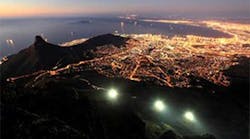JOHANNESBURG -- More than one in three Africans have entered the middle class in the past decade, and their numbers are set to increase thanks to rapid economic growth, a study showed Monday.
At least 370 million Africans, or 34% of the continent's 1.1 billion people, are described as members of the middle class, according to a survey by the African Development Bank.
In turn, the bulging middle class will help drive further economic growth and development, the Tunis-based AfDB said.
By 2060 the group should represent 42% of the population, according to the study launched in Johannesburg nearly 20 years ago.
"There is a stable middle class and it is growing," said Mthuli Ncube, the AfDB's chief economist and a senior research fellow with Oxford University's Blavatnik School of Government.
"It is a big driver for investment in Africa," he added at a news conference in Johannesburg.
The International Monetary Fund forecasts that Africa's economic growth, boosted by rising investment in natural resources and infrastructure, will reach 5.1% this year, up from 4.7% in 2013.
It should climb to 5.8% next year, the IMF predicts.
The study, which defined the middle class as having a purchasing power parity of between $2.20 and $20 a day, found that the middle class is strongest in countries with a robust and growing private sector.
North Africa leads the pack with at least 77% of its population counted among the middle class, surprisingly followed by the central African region at 36% of its people falling in that category -- though many are considered to be vulnerable.
The southern African region, home to the continent's most developed economy, South Africa, is in third place, level with west Africa with around 34% of their people classified as middle class.
East African countries are at the bottom of the ranking, having just a quarter of their nationals in the middle class.
Consumption and ownership of items such as a television set, car and refrigerator, and the type of flooring in dwellings were among the yardsticks used to define the class.
Other measurements included access to electricity, sources of drinking water and types of toilets.
Based on a survey of 37 African countries, the study polled nearly 800,000 households and concluded that most of the countries saw a rise in the size of the middle class over the past decade.
Copyright Agence France-Presse, 2014




